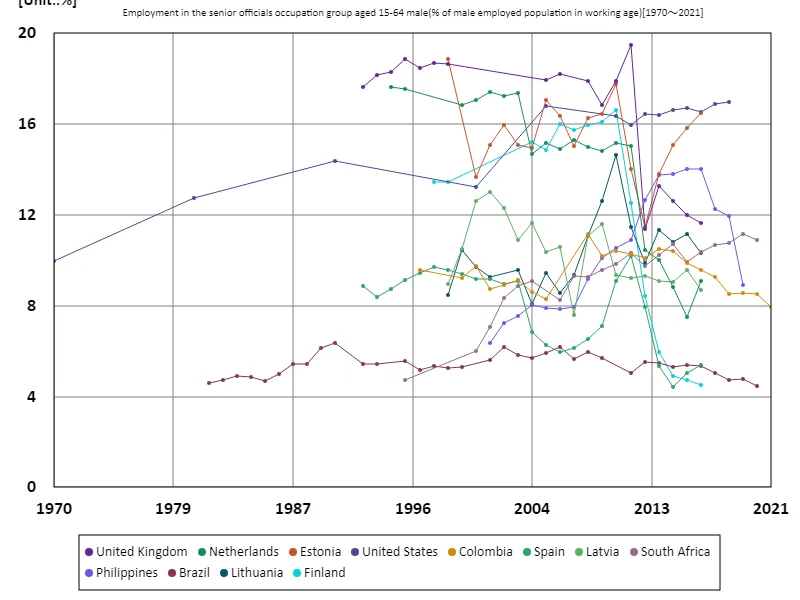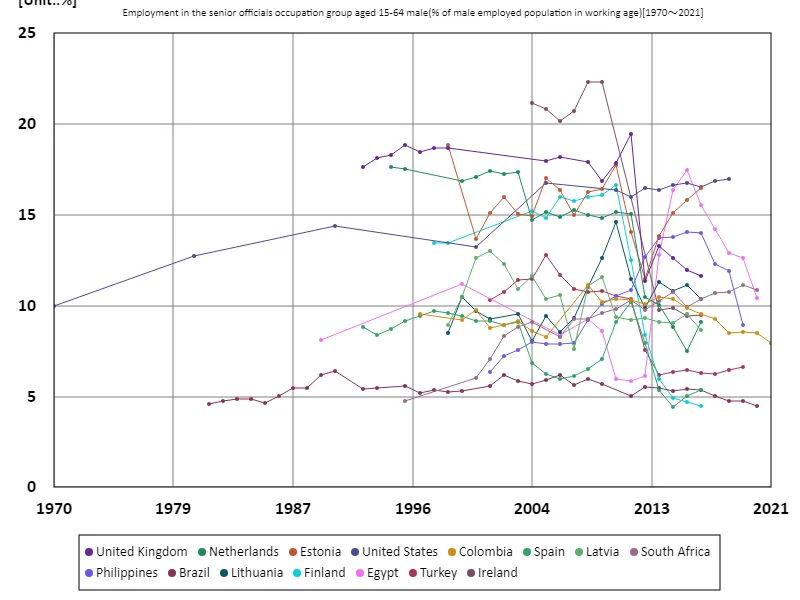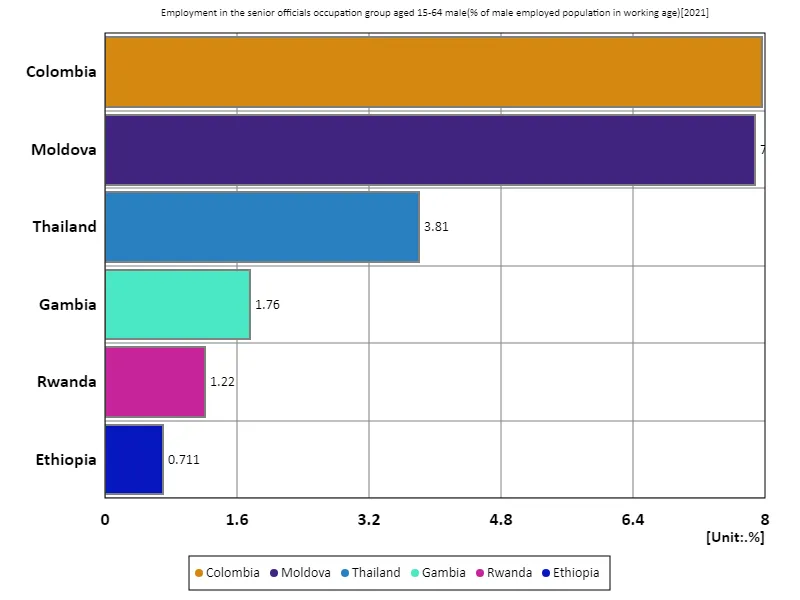- Abstract
- Employment rate for men aged 15-64 in the senior civil service sector (percentage of working-age males in the workforce)
- Employment rate of men aged 15-64 in senior civil service positions (percentage of working-age male population) (Worldwide)
- Employment rate of men aged 15-64 in senior civil service occupations (percentage of working-age male population in the labour force) (world, latest year)
- Reference
Abstract
According to 2021 data, Colombia has the highest employment rate in the senior civil service sector among men aged 15-64, at 7.96%. This indicator represents the ratio of senior civil servants to the total number of working-age men, reflecting the attractiveness of civil service jobs and the size of a country’s public sector. Recent trends show that employment rates in the senior civil service sector vary greatly from country to country, but generally a high employment rate indicates the development of a country’s civil service system and the size of its government organization. In countries with a high rate, such as Colombia, a career in civil service may be popular and valued for its stability and benefits. On the other hand, countries with low employment rates often have a relatively small public sector or a more developed private sector. In addition, countries with a high employment rate in the senior civil service sector are expected to have high administrative efficiency and high levels of civil servant expertise, but excessive reliance on the civil service can also become a financial burden. As a result, countries implement various policies to balance the number of civil servants.
Employment rate for men aged 15-64 in the senior civil service sector (percentage of working-age males in the workforce)
Looking at data from 1970 to 2021, employment in the senior civil service for men aged 15-64 peaked at 19.5% in the UK in 2011. This high percentage reflects the expansion of the British civil service and the growing importance of public administration. However, the current employment rate remains at 59.7% of its peak and has been declining in recent years. There are several possible factors behind this change. First, the number of civil servants may be declining relatively due to the increasing efficiency of government administration and the expanding role of the private sector. Additionally, fiscal consolidation and revisions to civil servant salaries may also be having an impact. The UK government has sought to make public services more efficient while maintaining necessary administrative functions, and as a result, although the size of the public debt has decreased from previous peaks, it still remains at a certain level. In general, fluctuations in employment rates in the civil service sector reflect the impact of a country’s policies, economic environment, and administrative reforms. Higher employment rates indicate an enhanced role for government, while declines often indicate an expanding private sector or more efficient public administration. The UK example also shows that economic and policy fluctuations have a direct impact on civil service employment.


The maximum is 19.5%[2011] of United Kingdom, and the current value is about 59.7%
Employment rate of men aged 15-64 in senior civil service positions (percentage of working-age male population) (Worldwide)
Data from 1970 to 2021 shows that employment in the senior civil service sector among men aged 15-64 reached its peak in Ireland in 2009 at 22.3%. Since then, Ireland’s current employment rate has reached a peak of 42.4%, which represents a significant increase. This increase can be attributed to the expansion of Ireland’s public sector and the strengthening role of government. Particularly after the 2008 economic crisis, public sector employment was valued as a means of providing stable jobs, which may have led to increased employment. Another factor is the increased demand for senior civil servants as the Irish government implements administrative reforms and improves public services. However, higher public sector employment also comes with risks. It is important to strike a balance, as excessive reliance on civil servants can lead to increased financial burdens and inefficient administration. The Irish experience highlights the impact that economic conditions and policy changes can have on employment in the civil service sector and offers useful lessons for other countries.


The maximum is 22.3%[2009] of Ireland, and the current value is about 42.4%
Employment rate of men aged 15-64 in senior civil service occupations (percentage of working-age male population in the labour force) (world, latest year)
According to 2021 data, Colombia has the highest employment rate in the senior civil service sector among men aged 15-64 at 7.96%, compared to an average of 3.89%, reaching a total of 23.3%. The data shows that employment of senior civil servants varies widely across countries. Colombia’s high employment rate reflects the country’s relatively large civil service sector and the highly valued status of senior civil servants. The high employment rate suggests that government administrative functions are strengthening and that careers in the public sector are stable. On the other hand, the low overall average of 3.89% means that the senior civil service sector is relatively small in many countries. This is a trend seen in countries with private sector-driven economic structures, government efficiency policies, and intense competition for civil service jobs. For example, countries that are making the public sector more efficient and expanding the private sector tend to have lower employment rates in the senior civil service sector. Overall, differences in employment rates across senior civil service sectors reflect differences in countries’ economic policies, administrative reforms, and the importance of the public sector. The role and size of civil service jobs are changing, influenced by each country’s economic situation and policies.


The maximum is 7.96% of Colombia, the average is 3.89%, and the total is 23.3%



Comments